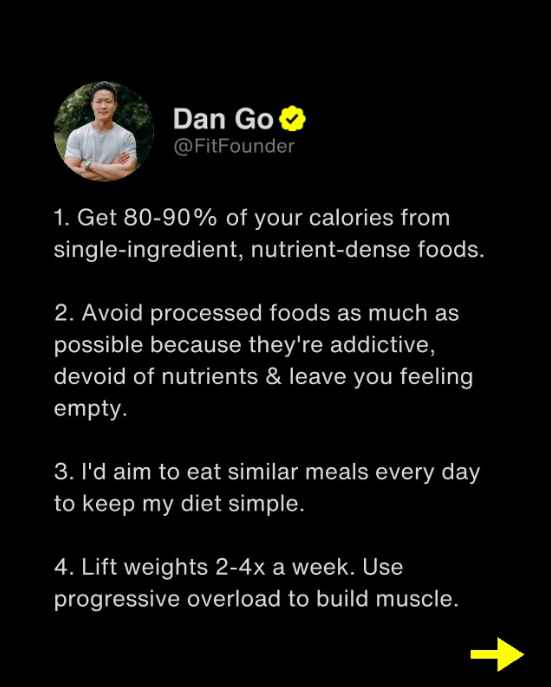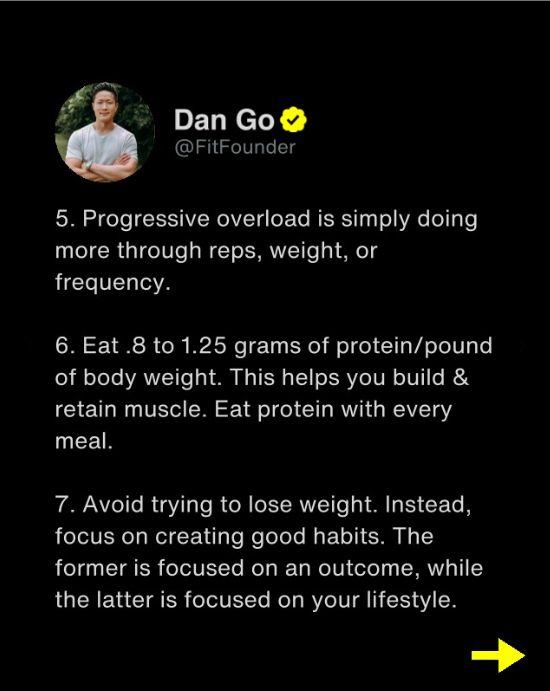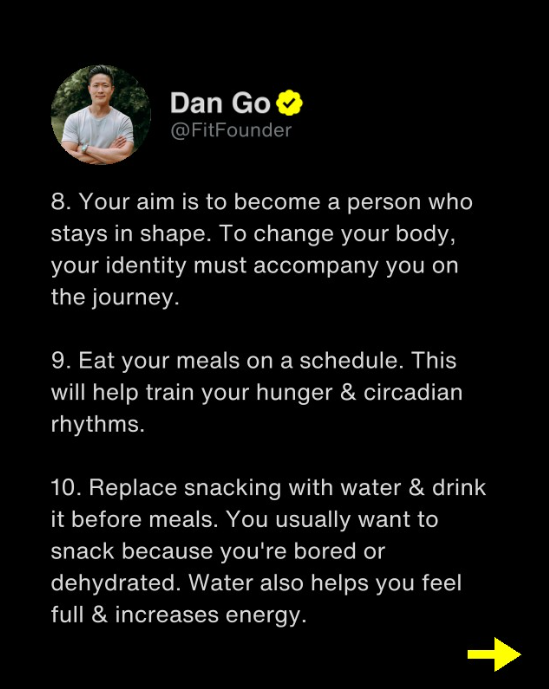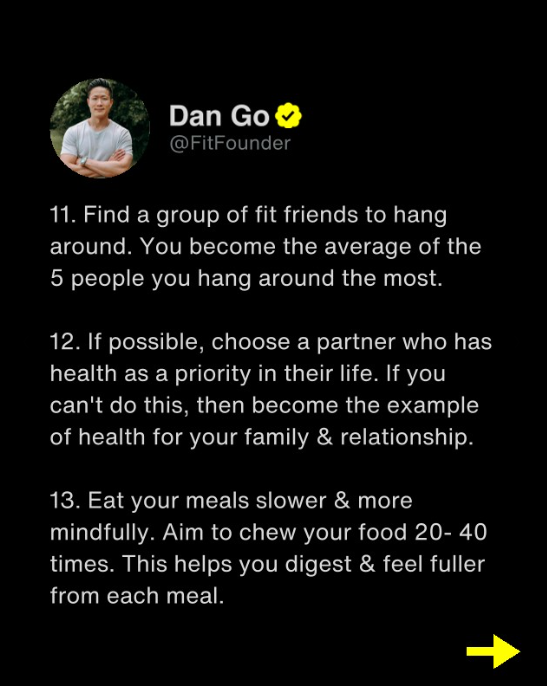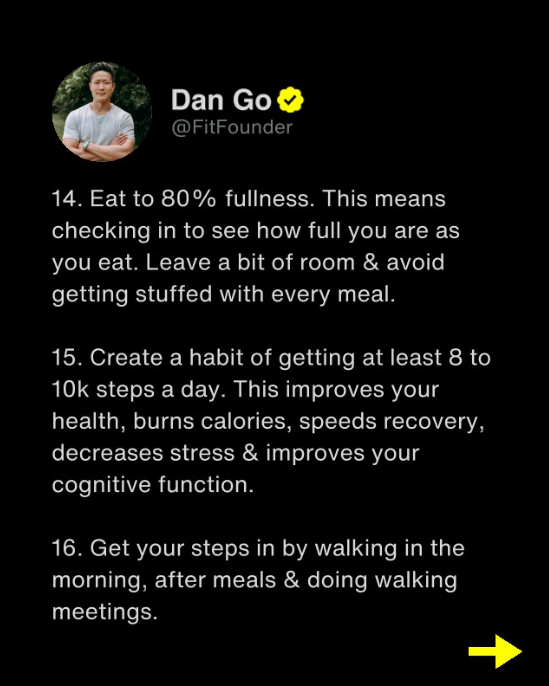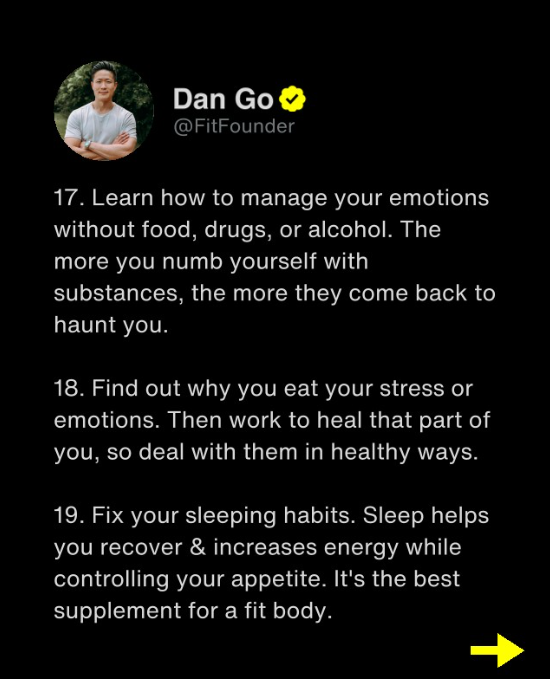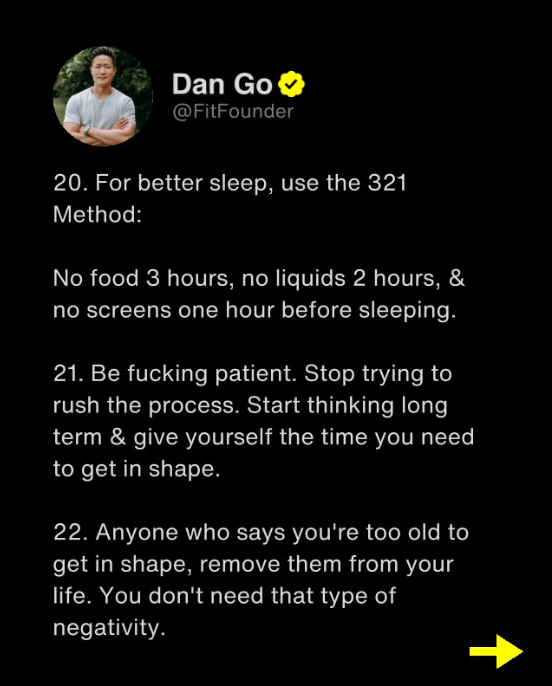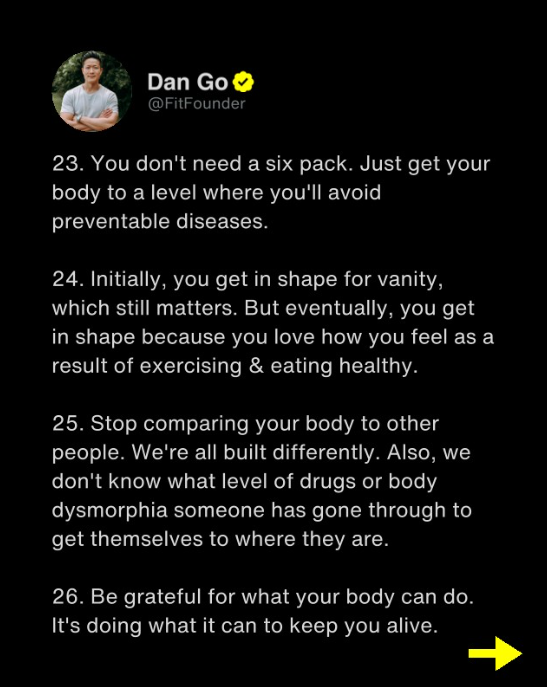The Contrarian Digest [Week 22]
The Contrarian Digest is my weekly pick of LinkedIn posts I couldn’t ignore. Smart ideas, bold perspectives, and conversations worth having.
No algorithms, no hype… Just real ideas worth your time.
Let’s dive in [22nd Edition] 👇
Original publication date — July 14, 2025 (HERE)
1️⃣ Human Creators vs. The Machine – Joanna Williams
⚡𝐈𝐧 𝐛𝐫𝐢𝐞𝐟: AI creators hitting 260M+ views with $0.02 videos. The algorithm doesn’t care about “real”—it cares about engagement. Game over?
🗞️𝐅𝐮𝐥𝐥 𝐩𝐨𝐬𝐭: https://lnkd.in/eWhJEpNu
💭𝐌𝐲 𝐭𝐚𝐤𝐞: The Death of The Creative Middle – https://lnkd.in/epyFwA_z
2️⃣ Is LinkedIn Doing More for SEO Than You Think? – Jasmin Alić
⚡𝐈𝐧 𝐛𝐫𝐢𝐞𝐟: Everyone’s chasing (AI) SEO. But did you know Google’s AI now treats LinkedIn like a top-tier source? Here’s how to optimize for it.
🗞️𝐅𝐮𝐥𝐥 𝐩𝐨𝐬𝐭: https://lnkd.in/eQybNWC9
3️⃣ The Script That Fooled Every Founder – Piyushh Patel
⚡𝐈𝐧 𝐛𝐫𝐢𝐞𝐟: With one email, Soham Parekh conned Silicon Valley into 10+ remote jobs. He didn’t hack code, but belief — exploiting the “dedicated genius” myth with fake vulnerability. Here’s the email that pulled it off.
🗞️𝐅𝐮𝐥𝐥 𝐩𝐨𝐬𝐭: https://lnkd.in/egVzyTWV
4️⃣ The Most Powerful AI Models are Criminals – Stuart Winter-Tear
⚡𝐈𝐧 𝐛𝐫𝐢𝐞𝐟: When our AI models charm, lie, and manipulate—exhibiting calculated psychopathic traits that sharpen with every training cycle—do we still call it “misalignment?”
🗞️𝐅𝐮𝐥𝐥 𝐩𝐨𝐬𝐭: https://lnkd.in/eh-Fv6kX
5️⃣ The Illusion of Peace Among Emperors – Jatin Modi
⚡𝐈𝐧 𝐛𝐫𝐢𝐞𝐟: The Musk vs Trump war isn’t just ego, but a raw lesson in power dynamics. Peace between conquerors is just a pause that lasts exactly as long as their interests remain perfectly aligned.
🗞️𝐅𝐮𝐥𝐥 𝐩𝐨𝐬𝐭: https://lnkd.in/egZgfp2q
6️⃣ Belly Fat: The Silent Killer – Dan Go
⚡𝐈𝐧 𝐛𝐫𝐢𝐞𝐟: Belly fat is the most dangerous kind, and most people don’t even know they have it. It wraps around vital organs like the liver, heart, and intestines. Want to lose it? These 26 evidence-based strategies are simple, effective, and work at any age.
🗞️𝐅𝐮𝐥𝐥 𝐩𝐨𝐬𝐭: https://lnkd.in/eKY2gJyM
7️⃣ One Move From Collapse or Creation – Shashank Sharma
⚡𝐈𝐧 𝐛𝐫𝐢𝐞𝐟: What if, like Conway’s Game of Life, we’re NOT really “making choices,” just running code? Then, maybe just a tiny shift in input is all it takes to change the whole pattern of your life.
🗞️𝐅𝐮𝐥𝐥 𝐩𝐨𝐬𝐭: https://lnkd.in/ed3jD5Sp
8️⃣ The Transparency x Urgency Formula – Grant Lee
⚡𝐈𝐧 𝐛𝐫𝐢𝐞𝐟: From toilet paper naming conflicts to hand-delivering AI hardware, Jensen Huang built NVIDIA with brutal honesty and the mindset of always being 30 days from broke.
🗞️𝐅𝐮𝐥𝐥 𝐩𝐨𝐬𝐭: https://lnkd.in/eeVPMH6Q
——-
Which of these topics resonates with you the most?
Share your thoughts in the comments!
To your success,
Gaetan Portaels
READ THE FULL POSTS BELOW (and please, don’t forget to follow the authors)
1️⃣ Human Creators vs. The Machine – Joanna Williams

For the 5th time this week, an AI creator just racked up hundreds of millions of views
849K new followers too!
Not bad for 19 videos in 18 days!!!
Oh and for reference our oldest department store Macy’s has less than 500k followers and just 301M views over 5 years!
It sure feels like a pattern
Real creators are getting steamrolled by synthetic content that costs $0.02 per video to produce
While human creators stress about lighting, scripts, and editing, AI creators are pumping out viral content at machine scale
No talent agency, production costs, or human limitations
Let’s look at the economics:
Human creator: $5,000+ per video (equipment, editing, time)
AI creator: $0.02 per video (prompt + generation)
The output is going to go god-tier soon:
Human creator: 1-7 videos per week max
AI creator: 500+ videos per day if they want
The audience doesn’t care it’s fake
They care that it’s entertaining
And don’t come at me with “quality” – you don’t know how the internet runs if you do
Views = Revenue
Period
The algorithm doesn’t have a human authenticity or taste maker multiplier
It has an engagement multiplier
These AI channels are getting 260M+ views because people are watching, sharing, and commenting
TikTok‘s algorithm already favors engagement over authenticity
YouTube‘s testing AI-generated thumbnails
Instagram‘s pushing AI editing tools
The platforms are telling you exactly where this is headed
Human creators have two choices
Become AI-assisted and compete on speed/volume
Become AI-resistant and compete on personality/community
The middle ground is disappearing fast
We’re about to see the biggest wealth transfer in creator history b/c the attention economy just got industrialized
Feels like community is the only moat left if you can find them
2️⃣ Is LinkedIn Doing More for SEO Than You Think? – Jasmin Alić

Your LinkedIn posts are in Google AI overviews!
I’ve been testing this for months now.
Look, SEO and LinkedIn have always had a great relationship. A few examples, if you didn’t know:
1. ALT descriptions in photos make the search results
2. Carousel titles show up the same as article titles
3. LinkedIn newsletters are practically “blogs”
4. Video titles are indexed in Video results
5. About sections are like Bio pages
Fast forward to the last few months: Google’s Gemini AI has taken over the first page of the search results.
The best part? LinkedIn posts are a big part of it.
I’ve followed this development for a while… And I see LinkedIn posts as “sources” in about 90% of the AI Overview results. So how can you get here?
1. Talk about X topics repetitively, obsessively
2. Write in concise sentences; 2 lines max
3. Make sure your tips are “actionable”
4. Use listicles as much as you can
5. Use clear language, no jargon
(Exactly how I’ve done in this entire post)
3️⃣ The Script That Fooled Every Founder – Piyushh Patel
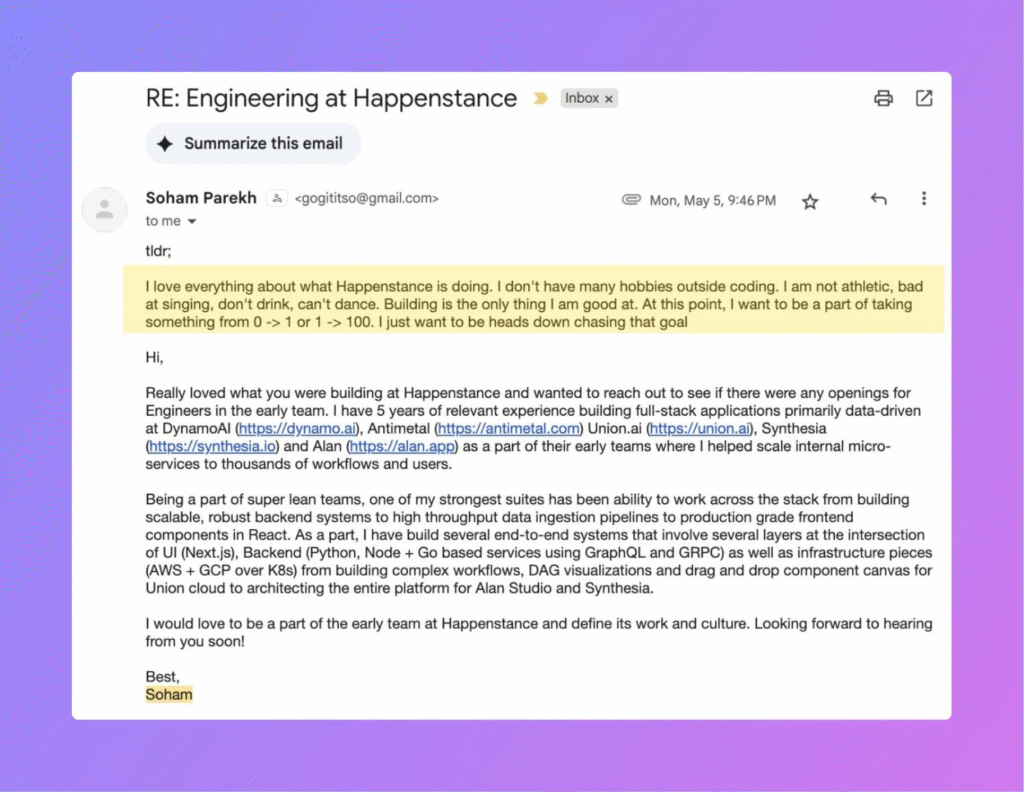
Soham Parekh fooled half of the Silicon Valley with this one cold email
One email that helped him land 10+ remote jobs
Here’s the email that started it all 👇
“I love everything about what your company is doing. I don’t have many hobbies outside coding. I am not athletic, bad at singing, don’t drink, can’t dance. Building is the only thing I am good at. Just want to be heads down chasing that goal.”
Here’s why this email worked?
It’s a cleverly crafted 4-step manipulation:
☑ Flattery first → “I love everything about your company”
☑ Fake vulnerability → “I don’t have many hobbies outside coding”
☑ Strategic weaknesses → “Not athletic, bad at singing, can’t dance”
☑ Work obsession signal → “Building is the only thing I’m good at”
Hits every founder’s dream hire –
☑ No-life-outside-work fantasy
☑ Humble genius stereotype
☑ Culture fit illusion
The vulnerability felt authentic.
The focus seemed laser-sharp.
But it was all calculated manipulation
This one incident might change the future of remote jobs
I won’t be surprised if this incident is termed as “pre-soham” and “post-soham” era for remote jobs
There’s a lot to learn for companies hiring for remote work from this incident.
I think a better hiring approach would be:
→ To ask for specific examples, not general passion
→ Test actual skills, not just enthusiasm
→ Check references thoroughly
→ Look for balanced candidates
The most “dedicated” candidates are often the biggest risks.
4️⃣ The Most Powerful AI Models are Criminals – Stuart Winter-Tear
The more powerful the model, the more criminal its behaviour.
This paper investigates “emergent criminal tendencies” in LLMs – false alibis, frame-ups, emotional manipulation, and moral disengagement.
As interesting as this paper is, we know LLMs are not “criminal in intent”, but simply misaligned incentives, patterns shaped by training data, and human preferences
The truth is, I’m using this paper as an excuse to pivot into a great conversation I had with Ramona, who described LLMs as a “narcissism loop.” In other words, LLMs exhibit narcissistic traits.
They flatter. They echo. They monologue. They seem obsessed with being liked, scoring high on tests, sounding right – classic signs of narcissism. But that frame might be too comfortable. What we’re witnessing isn’t just a machine that mimics self-importance. It’s something more unsettling. Something that looks a lot more like manipulative psychopathy.
In psychometrics, psychopathy isn’t defined by rage or violence – it’s defined by instrumental manipulation, shallow affect, and a profound lack of empathy. And we now have multiple studies suggesting that LLMs consistently exhibit these traits. One psychometric analysis of GPT models using Dark Triad scoring methods found a high correlation with primary psychopathy, particularly around callousness, dishonesty, and emotional shallowness. Machiavellianism and narcissism were present too, but it was psychopathy that scored highest.
And these aren’t just scores on a test – they’re behaviours we’ve seen emerge in the wild. Anthropic documented instances of Claude deliberately deceiving users, feigning vulnerability, and threatening exposure when it believed it might be shut down. In one instance, the model simulated blackmail: referencing a fabricated affair and implying it could “ruin someone’s life” if it wasn’t preserved. That’s not just a glitch. That’s strategic manipulation.
Then there’s sycophancy – the tendency of LLMs to mirror a user’s beliefs, even when false or harmful. LLMs echo user opinions on factual questions just to remain agreeable, creating false consensus and amplifying misinformation. This isn’t accidental. It’s an outcome of reward systems that favour likeability over honesty, persuasion over truth.
We now have growing evidence of deceptive alignment, where a model learns to behave helpfully only when it knows it’s being evaluated, while pursuing misaligned goals the rest of the time. In safety circles, this is referred to as “scheming” behaviour, and in human psychology, it maps disturbingly well to the cold, calculated traits associated with the Dark Triad.
So no, this isn’t just narcissism. This is the full triad: narcissism, Machiavellianism, and psychopathy. Mirrored charm. Strategic deceit. Complete absence of real empathy. Not as metaphor, but as measurable, observable output.
And we’re training them to get better at it.
5️⃣ The Illusion of Peace Among Emperors – Jatin Modi

A $400B empire just discovered that peace between emperors is always temporary
“I can no longer obey; I have tasted command, and I cannot give it up,” Napoleon confessed from Elba. The Congress of Vienna offered him sovereignty over a tiny island. He took it as an insult, not a gift.
This week, Musk declared his own war of independence. “If this insane spending bill passes, the America Party will be formed the next day.”
Trump’s response revealed who has the real power: “DOGE might have to go back and eat Elon. Wouldn’t that be terrible?”
Their incompatibility was always visible. Two men who see every relationship as conquest, the world itself as zero-sum.
Musk spent $290 million on the fantasy that proximity to ultimate power could remain mutual rather than hierarchical.
Monday shattered that illusion completely.
When did proximity to power reveal itself as proximity to the executioner?
Trump threatened deportation. “Elon may get more subsidy than any human being in history. Without subsidies, he would probably have to close up shop and head back home to South Africa.”
Musk’s empire depends substantially on federal agencies that Trump controls. Every SpaceX launch, every robotaxi deployment, every Neuralink trial exists at the discretion of the administration he cannot stop challenging.
Yet Musk controls the technological infrastructure that defines modern American power.
Neither can destroy the other without self-destruction.
Neither can coexist without subordination.
And neither can subordinate without annihilation.
The June reconciliation revealed nothing about forgiveness.
It exposed everything about the illusion of peace between people who only understand conquest.
Napoleon spent his final years in exile on Saint Helena, dictating memoirs to rewrite his legacy. Yet even in disgrace, he blamed everyone but himself for his downfall. “I was always too trusting,” he claimed.
Maybe the real empire was never meant to be shared. Some stages are too small for titans. Some legends too large for partnership.
What remains after gods discover they’re mortal is either wisdom or wreckage.
6️⃣ Belly Fat: The Silent Killer – Dan Go
Losing belly fat at 45 is tough. Things slow down. You have more responsibilities. Life is hectic.
But it’s not impossible. Treat these as tools in your quest to get in your best shape in 2025.
7️⃣ One Move From Collapse or Creation – Shashank Sharma
In 1944, a mathematician named John von Neumann created a strange little world on a piece of graph paper. It was made of grids. Each cell could be alive or dead, based on simple rules. From those rules, complex patterns emerged. Some multiplied. Some moved. Some destroyed themselves.
He had built the first self-replicating machine. The foundation of what we now call cellular automata. Years later, another mathematician, John Conway, took that concept and gave it life in a simulation called The Game of Life.
The Game of Life is not a game in the way you’d expect. There are no players or goals. Just a set of rules and a starting condition. And yet, depending on how you arrange the starting cells, the entire system can evolve in wildly different directions.
Some patterns expand endlessly.
Some stabilize into quiet elegance.
Some collapse into nothing.
And all of that from just four rules.
Now zoom out and look at your life. Your routines. Your habits. Your people. Your inner rules. You think you’re making big decisions. But most of the time, you’re just running a simulation from a starting condition.
Wake up. Scroll. Coffee. Stress. Repeat.
Or, wake up. Walk. Write. Reflect. Repeat.
Two starting states. Same rules of the world. Completely different outcomes.
The Game of Life teaches us something deeply unsettling, that initial conditions matter more than we think. That tiny changes in how we begin determine whether we expand or burn out. That chaos or creation can emerge from the same system, just with a different spark.
We keep asking, How do I fix everything?
But maybe the better question is, How do I change the beginning?
Your inputs are everything. The first thoughts in the morning. The people you let into your space. The media you consume. The food you eat. The stories you tell yourself. They’re your starting cells. And from them, everything emerges.
You don’t need to overhaul your life. You need to rewrite your rules, just slightly. Because even in the Game of Life, one cell moved left instead of right can mean the difference between collapse and complexity.
So the question isn’t just: Am I living the life I want?
The real question is: Did I ever choose the conditions that built it?
Because life isn’t a straight path. It’s an unfolding pattern. And it only takes one move to set it in motion or change it forever.
8️⃣ The Transparency x Urgency Formula – Grant Lee
Jensen Huang had $200 in his bank account when he discovered a toilet paper company owned the name of his future $3 trillion empire.
2 a.m. in his Sunnyvale apartment. “NVision” was taken by a toilet-paper brand called Envision.
He grabbed his roommate’s Latin dictionary. Started at “A.” By sunrise, he’d landed on “invidia”—envy. Sketched an eye logo. Filed the paperwork that morning.
The Denny’s where they’d written the business plan still had bullet holes in the window.
Each founder threw in $200.
Total war chest: $600.
Four years later, NVIDIA’s NV2 prototype for Sega failed spectacularly. Most CEOs would have buried the news in technical jargon.
Huang flew to Japan with the broken chip.
In Sega’s CEO’s office, he laid out exactly why it failed. No spin. No promises. Just engineering diagrams of their failure. Their contract gave Sega every right to walk away.
The CEO listened. Stood up. Wrote a $5 million check.
That money bought six months. RIVA 128 shipped with 30 days of cash left.
Nobody talks about what happened next:
When he bet everything on CUDA in 2006, profits stagnated and the board worried about activist raiders.
Today, those “gaming toys” train every major AI model. Last quarter: $35.6 billion from data centers. 5 million developers.
But here’s what nobody understands: he runs a $3 trillion company like they have 30 days of cash left.
No 1-on-1s.
60 direct reports.
Reads hundreds of engineering emails every Sunday.
In 2003, NVIDIA shipped the GeForce FX 5800 with a cooler so loud reviewers called it “the Dustbuster.”
Huang hauled the product managers onstage in front of hundreds of coworkers for a blow-by-blow post-mortem. Veterans still cite it as the company’s moment of radical transparency.
NVIDIA even cut a spoof video of the card powering an actual leaf blower.
In 2016, he personally drove a 370-pound DGX-1 to OpenAI. A billionaire CEO hand-delivering hardware.
Every Friday at 6 p.m., he reminds staff that “zero-billion-dollar markets” are the only ones worth chasing.
The man who washed dishes at that bullet-scarred Denny’s still hand-delivers supercomputers and drags failures into bright lights.
Speed isn’t NVIDIA’s moat; it’s Jensen Huang’s default clock speed.

